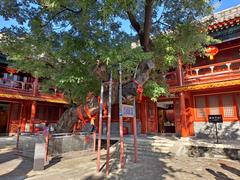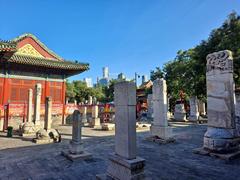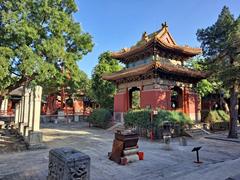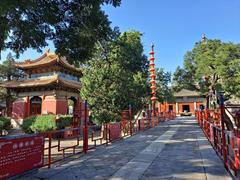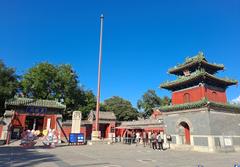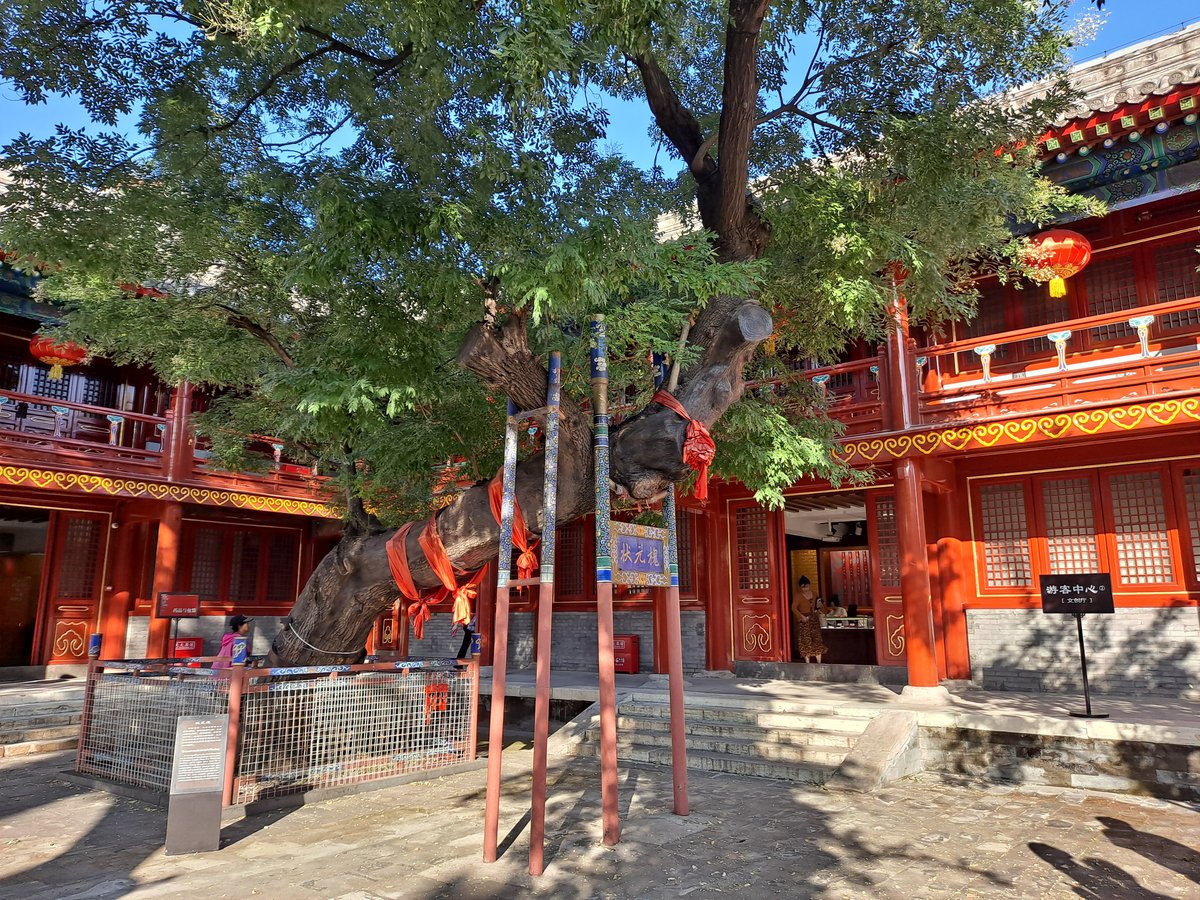
Beijing Dongyue Temple: Visiting Hours, Tickets, and Historical Guide
Date: 14/06/2025
Introduction
Dongyue Temple (东岳庙), nestled in central Beijing’s Chaoyang District, stands as a testament to China’s Taoist traditions, architectural artistry, and vibrant folk culture. Established during the Yuan dynasty in the early 14th century, the temple is dedicated to the Great Deity of the Eastern Peak, Mount Tai (Taishan), a central figure in Taoist cosmology. Over centuries, Dongyue Temple has transformed from a dynastic spiritual center into a living museum, preserving intangible cultural heritage and offering visitors a uniquely immersive encounter with Beijing’s religious and historical legacy (chinabeijingprivatetour.com; travelchinaguide.com; english.visitbeijing.com.cn).
This guide provides detailed information on Dongyue Temple’s visiting hours, tickets, accessibility, historical highlights, and travel tips, making it an essential resource for travelers, cultural enthusiasts, and spiritual seekers.
Table of Contents
- Introduction
- Historical Background and Architectural Evolution
- Artistic and Cultural Treasures
- 20th Century Challenges and Restoration
- Visitor Information
- Museum and Exhibitions
- Etiquette, Photography, and Practical Tips
- Nearby Attractions & Itinerary Planning
- Frequently Asked Questions (FAQ)
- Visuals and Interactive Resources
- Conclusion
- References & Further Reading
Historical Background and Architectural Evolution
Founding and Dynastic Development
Dongyue Temple was founded in 1319 by Zhang Liusun, a distinguished Taoist official, and completed by his disciple Wu Quanjie in 1322. Dedicated to the God of Mount Tai—considered the overseer of life, death, and fate—the temple quickly became Beijing’s largest Zhengyi Taoist temple (chinabeijingprivatetour.com; visitbeijing.com.cn).
The temple’s original layout featured three main courtyards and was expanded over subsequent dynasties. Major restorations during the Ming (1447) and Qing (1698, 1761) periods preserved elements from each era, resulting in a harmonious architectural blend.
Layout and Features
Dongyue Temple exemplifies the north-south central axis design common to imperial Chinese architecture. Stretching over 47,000–60,000 square meters, the complex comprises more than 370 rooms arranged along a processional axis. Key structures include:
- Glazed Archway (琉璃牌楼): Built in 1602, this ornate entrance features yellow glazed tiles and intricate carvings, symbolizing the threshold from the secular to the sacred (ruqintravel.com).
- Daiyue Hall (岱岳殿): The main sanctuary, housing the grand golden statue of the Dongyue Emperor, adorned with imperial motifs.
- Yude Hall: Another significant hall for Taoist rituals, featuring elaborate woodwork and statuary.
- Lingxing Gate, Zhandai Gate, and Rear Hall: Architectural highlights along the temple’s axis, each with distinct ceremonial functions.
Artistic and Cultural Treasures
Stone Steles and Calligraphy
Dongyue Temple is famed for its collection of over 160 ancient stone steles—Beijing’s largest temple collection. Among these, a Yuan-dynasty stele with an inscription by Zhao Mengfu stands out as a national first-class cultural relic, chronicling the temple’s founding and religious significance (beijing-visitor.com).
Statues and Dioramas
The temple’s “76 Departments of the Underworld” line the central courtyard, each small chamber depicting a bureaucratic office of the Taoist afterlife. Hundreds of vibrantly painted clay figures illustrate scenes of judgment and spiritual administration, providing an extraordinary window into Chinese beliefs about morality and the afterlife (ruqintravel.com).
Poetic Couplets and Decorative Details
Dozens of poetic couplets, calligraphic plaques, and decorative carvings adorn the halls and gates. These elements blend Taoist philosophy with artistic expression, inviting contemplation on life, fortune, and harmony.
East and West Courtyards
- East Courtyard: Landscaped with rare plants and pavilions, evoking imperial refinement.
- West Courtyard: Features shrines to popular folk deities, including the Medicine King and gods of wealth and fertility—a testament to the temple’s community role.
20th Century Challenges and Restoration
Dongyue Temple suffered significant damage during the Cultural Revolution, with many statues and relics lost or destroyed. Restoration efforts began in the late 20th century, culminating in major renovations in 2002 and a comprehensive restoration completed in 2023. These projects revived the temple’s original ambiance through traditional techniques and preserved surviving artifacts, ensuring the site’s longevity (chinabeijingprivatetour.com; visitbeijing.com.cn).
Visitor Information
Visiting Hours & Ticketing
- Hours: Open daily from 8:30 AM to 4:30 PM (subject to seasonal/holiday variations).
- Tickets: Standard admission is 10–20 RMB per adult (discounts for students, seniors, and children). Tickets are available at the entrance; electronic payments (Alipay, WeChat Pay) are accepted.
Accessibility & Facilities
- Location: 141 Chaoyangmen Outer Street, Chaoyang District, Beijing.
- Transport: Nearest subway stations: Chaoyangmen (Lines 2 & 6), Dongdaqiao (Line 6); multiple bus routes nearby.
- Facilities: Clean restrooms, souvenir shops, bilingual signage, and flat main courtyards facilitate navigation.
- Mobility: While historic steps limit wheelchair access in some areas, main courtyards are relatively accessible.
Guided Tours & Special Events
- Guided Tours: Private English-speaking guides can be booked through agencies; audio guides (Chinese/English) may be available.
- Festivals: The annual Dongyue Temple Fair (first lunar month) features folk performances, crafts, and food stalls; special exhibitions coincide with major Chinese festivals.
Museum and Exhibitions
Dongyue Temple houses the Beijing Folklore Museum, offering rotating exhibitions on local customs, crafts, and seasonal celebrations. Interactive workshops and performances enrich the visitor experience, especially during festival periods (Ruqin China Travel).
Etiquette, Photography, and Practical Tips
- Etiquette: Dress modestly; avoid loud conversation; observe rituals respectfully; incense burning permitted in designated areas.
- Photography: Permitted outdoors; check for restrictions inside halls—no flash or tripods in sensitive areas.
- Tips: Arrive early for quieter visits; check weather and event schedules; bring cash or mobile payment apps; comfortable shoes recommended.
Nearby Attractions & Itinerary Planning
Dongyue Temple’s central location enables easy combination with:
- The Workers’ Stadium: Sports and entertainment hub.
- Sanlitun: Shopping and nightlife district.
- Ritan Park: Historic imperial altar and gardens.
- Confucius Temple & Guozijian Museum: Close by for cultural explorers.
A typical visit lasts 1–2 hours, and pairing with nearby sites makes for a rewarding half-day itinerary.
Frequently Asked Questions (FAQ)
Q: What are Dongyue Temple’s visiting hours?
A: 8:30 AM to 4:30 PM daily (verify during holidays).
Q: How much is admission?
A: 10–20 RMB per adult, with discounts available.
Q: Is Dongyue Temple accessible for people with disabilities?
A: Main courtyards are accessible, but some steps and uneven paths remain.
Q: Are guided tours available in English?
A: Not always officially, but private guides and audio guides can be arranged.
Q: Can I take photos inside the temple?
A: Yes in most outdoor areas; restrictions may apply inside halls.
Q: Are there special events or festivals?
A: Yes, especially the Dongyue Temple Fair and major holiday celebrations.
Visuals and Interactive Resources
- Images: Glazed Archway, main halls, statues, and courtyard scenes (alt text recommended for accessibility).
- Maps: Layout of temple grounds and nearby attractions.
- Virtual Tour: Check official or tourism websites for virtual experiences.
Conclusion
Dongyue Temple is a captivating site where spiritual tradition, historical architecture, and living culture converge. From its storied founding and artistic treasures to its ongoing role as a community hub and museum, the temple offers an enriching experience for every visitor. Plan ahead by confirming hours and ticket prices, consider joining a tour for deeper insights, and don’t miss the vibrant festivals that showcase Beijing’s enduring folk traditions.
For additional travel resources, updates, and interactive guides, download the Audiala app and follow us on social media. Explore related articles on Beijing’s historical sites for a comprehensive cultural journey.
References & Further Reading
- Dongyue Temple Beijing: Visiting Hours, Tickets, and Historical Guide, chinabeijingprivatetour.com
- Discover Dongyue Temple: Visiting Hours, Tickets, and Cultural Significance, chinatripedia.com
- Dongyue Temple Beijing: Visiting Hours, Tickets & Architectural Highlights, ruqintravel.com
- Dongyue Temple Visiting Hours, Tickets, and Guide, ruqintravel.com
- Dongyue Temple, travelchinaguide.com
- Dongyue Temple Beijing, english.visitbeijing.com.cn
- Visit Here: Dongyue Temple & Folklore Museum, thebeijinger.com
